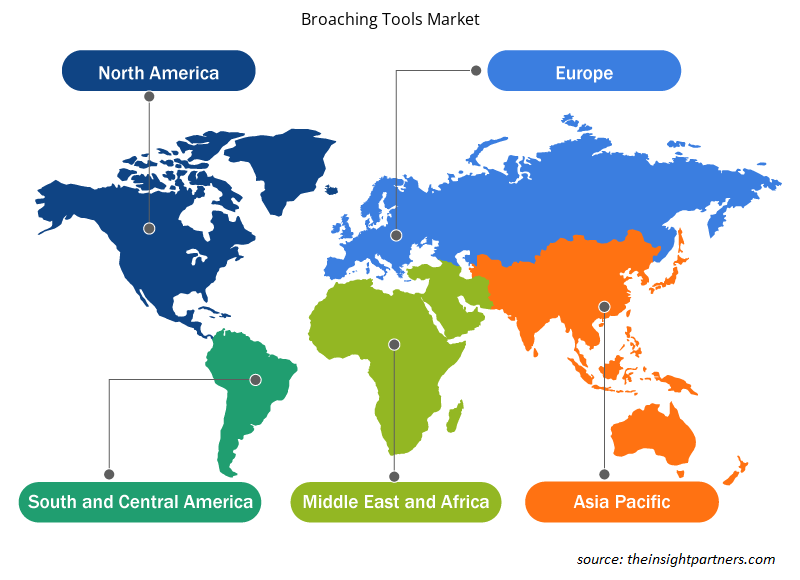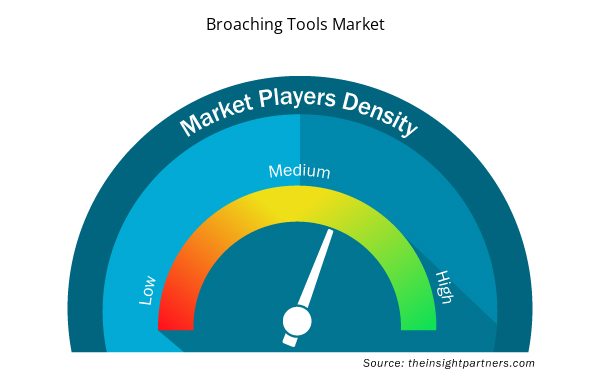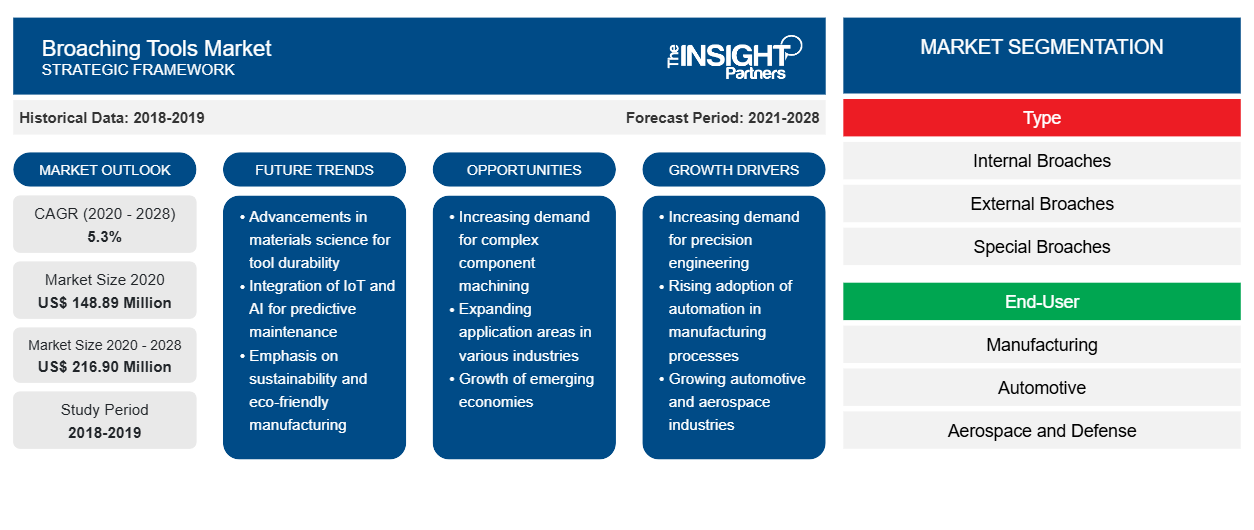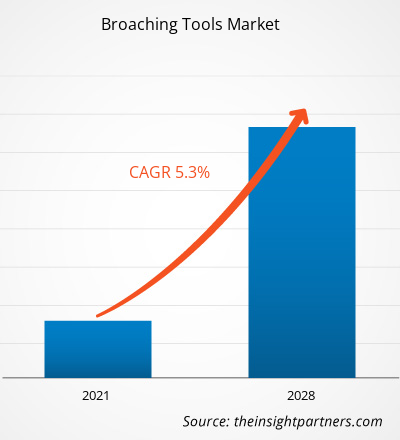Le marché des outils de brochage a été évalué à 148,89 millions USD en 2020 et devrait atteindre 216,90 millions USD d'ici 2028 ; il devrait croître à un TCAC de 5,3 % au cours de la période 2021-2028.
En raison de la croissance économique mondiale, le secteur manufacturier a gagné en popularité au cours des deux dernières décennies, en particulier dans les économies émergentes de l'Asie-Pacifique. Les outils de brochage sont largement utilisés pour produire divers composants industriels et pièces de sous-assemblage. La demande croissante de processus de finition rapides et précis de la part des secteurs d'utilisation finale tels que l'automobile, l'aérospatiale et la défense et la construction encourage les fabricants d'outils de brochage à introduire des outils avancés sur le marché. Le secteur manufacturier est l'un des principaux moteurs de la croissance économique de l'APAC. Des facteurs tels que le faible coût de la main-d'œuvre, l'augmentation de la population jeune et les avantages gouvernementaux sous forme de filiales et d'incitations fiscales incitent les organisations à créer des bases de fabrication plus importantes en Asie-Pacifique. En outre, les initiatives gouvernementales telles que Made in China 2025 et Make in India propulsent la croissance du secteur manufacturier en Asie-Pacifique. En outre, l'augmentation du revenu disponible des masses conduit à l'adoption croissante du mode de vie moderne dans la région, ce qui alimente la demande d'électronique grand public et d'automobiles. Ce facteur renforce le secteur manufacturier. Par conséquent, le secteur manufacturier en pleine croissance stimule la croissance du marché des outils de brochage en Asie-Pacifique.
Personnalisez ce rapport en fonction de vos besoins
Vous bénéficierez d'une personnalisation gratuite de n'importe quel rapport, y compris de certaines parties de ce rapport, d'une analyse au niveau des pays, d'un pack de données Excel, ainsi que de superbes offres et réductions pour les start-ups et les universités.
- Obtenez les principales tendances clés du marché de ce rapport.Cet échantillon GRATUIT comprendra une analyse de données, allant des tendances du marché aux estimations et prévisions.
Impact de la pandémie de COVID-19 sur le marché des outils de brochage
L'épidémie de COVID-19 affecte négativement les industries du monde entier et cet effet dévastateur se poursuit également en 2021. L'épidémie a créé des perturbations importantes dans les industries primaires telles que la fabrication, la santé, l'énergie et l'électricité, l'électronique et les semi-conducteurs, l'aérospatiale et la défense et la construction. Une baisse significative des activités dans les industries mentionnées a un impact négatif sur les performances du marché des outils de brochage . La réapplication de mesures de confinement telles que les restrictions de voyage, les interdictions commerciales et la limitation de la main-d'œuvre sur les lieux de travail a perturbé la fabrication, l'approvisionnement et les ventes de diverses entreprises, y compris les équipements industriels tels que les outils de brochage.
Informations sur le marché des outils de brochage
Production automobile en hausse
Ces dernières années, la demande de véhicules haut de gamme a augmenté, ce qui a entraîné une augmentation de la production de véhicules, principalement dans les régions développées telles que l'Amérique du Nord et l'Europe. De plus, la demande de véhicules utilitaires et de voitures particulières, principalement dans les pays en développement, augmente. Les outils de brochage sont largement utilisés dans le secteur automobile pour fabriquer des engrenages, des arbres de transmission, des moyeux de volant, des fourches de direction et autres. Selon le Center for Automotive Research, une organisation à but non lucratif, en 2018, les constructeurs automobiles tels que FCA, GM, Ford, Hyundai, Nissan, Volkswagen et Toyota ont investi 4,8 milliards de dollars américains dans l'industrie automobile. En outre, les investissements automobiles dans la recherche et le développement (R&D) ont augmenté de 6,7 % pour atteindre 67,09 milliards de dollars américains par an en Europe. Ainsi, la demande croissante de véhicules haut de gamme et l'augmentation de la production de véhicules stimulent l'adoption des outils de brochage dans l'industrie automobile.
Informations sur le marché basées sur les types
En fonction du type, le marché des outils de brochage est segmenté en broches internes, broches externes et broches spéciales. Le segment des broches internes détenait la plus grande part en 2020. Le marché du segment des broches internes devrait croître à un rythme plus rapide au cours de la période de prévision en raison de la demande croissante de machines à brocher verticales. La technique de brochage interne est largement utilisée pour produire divers composants de précision, tels que des engrenages pour automobiles et machines, des composants d'armes à feu et des fixations. Avec la croissance constante de l'industrialisation à travers le monde, le marché des outils de brochage devrait connaître une croissance significative au cours de la période de prévision.
Les acteurs opérant sur le marché des outils de brochage se concentrent sur des stratégies telles que les fusions, les acquisitions et les initiatives de marché pour maintenir leurs positions sur le marché. Quelques développements des principaux acteurs sont énumérés ci-dessous :
- En 2020, Blohm Jung GmbH a lancé sur le marché le PROFIMAT XT avec changeur d'outils. L'outil permet un changement automatique des meules. Ce PROFIMAT XT flexible réunit quatre technologies de rectification dans une seule machine : rectification alternative, rectification par avance lente, rectification par avance continue et rectification par avance rapide.
- En 2018, la société Blohm Jung GmbH a présenté en première mondiale au salon IMTS son nouveau produit appelé PROFIMAT XT. Ce lancement constitue une extension de sa gamme de rectifieuses.
Aperçu régional du marché des outils de brochage
Les tendances régionales et les facteurs influençant le marché des outils de brochage tout au long de la période de prévision ont été expliqués en détail par les analystes d’Insight Partners. Cette section traite également des segments et de la géographie du marché des outils de brochage en Amérique du Nord, en Europe, en Asie-Pacifique, au Moyen-Orient et en Afrique, ainsi qu’en Amérique du Sud et en Amérique centrale.

- Obtenez les données régionales spécifiques au marché des outils de brochage
Portée du rapport sur le marché des outils de brochage
| Attribut de rapport | Détails |
|---|---|
| Taille du marché en 2020 | 148,89 millions de dollars américains |
| Taille du marché d'ici 2028 | 216,90 millions de dollars américains |
| Taux de croissance annuel composé mondial (2020-2028) | 5,3% |
| Données historiques | 2018-2019 |
| Période de prévision | 2021-2028 |
| Segments couverts | Par type
|
| Régions et pays couverts | Amérique du Nord
|
| Leaders du marché et profils d'entreprises clés |
|
Densité des acteurs du marché : comprendre son impact sur la dynamique des entreprises
Le marché des outils de brochage connaît une croissance rapide, tirée par la demande croissante des utilisateurs finaux en raison de facteurs tels que l'évolution des préférences des consommateurs, les avancées technologiques et une plus grande sensibilisation aux avantages du produit. À mesure que la demande augmente, les entreprises élargissent leurs offres, innovent pour répondre aux besoins des consommateurs et capitalisent sur les tendances émergentes, ce qui alimente davantage la croissance du marché.
La densité des acteurs du marché fait référence à la répartition des entreprises ou des sociétés opérant sur un marché ou un secteur particulier. Elle indique le nombre de concurrents (acteurs du marché) présents sur un marché donné par rapport à sa taille ou à sa valeur marchande totale.
Les principales entreprises opérant sur le marché des outils de brochage sont :
- Société américaine de brochage et de machines
- Arthur Klink GmbH
- Groupe d'outils Colonial Inc.
- Coopérative Ekin S
- Blohm Jung GmbH
Avis de non-responsabilité : les sociétés répertoriées ci-dessus ne sont pas classées dans un ordre particulier.

- Obtenez un aperçu des principaux acteurs du marché des outils de brochage
Le marché mondial des outils de brochage a été segmenté comme suit :
Marché des outils de brochage – par type
- Broches internes
- Broches externes
- Broches spéciales
Marché des outils de brochage – par utilisateur final
- Fabrication
- Automobile
- Aérospatiale et Défense
- Construction
- Autres
Marché des outils de brochage – par géographie
Amérique du Nord
- NOUS
- Canada
- Mexique
Europe
- France
- Allemagne
- Italie
- Russie
- ROYAUME-UNI
- Reste de l'Europe
Asie-Pacifique (APAC)
- Chine
- Inde
- Japon
- Australie
- Corée du Sud
- Reste de l'APAC
Moyen-Orient et Afrique (MEA)
- Arabie Saoudite
- Émirats arabes unis
- Afrique du Sud
- Reste de la MEA
Amérique du Sud (SAM)
- Brésil
- Argentine
- Reste de SCAM
Profils d'entreprise
- Société américaine de brochage et de machines
- Arthur Klink GmbH
- Groupe d'outils Colonial Inc.
- Coopérative Ekin S
- Blohm Jung GmbH
- Messer Räumtechnik GmbH & Co. KG
- Mitsubishi Heavy Industries Machine Tool Co., Ltd.
- Nachi-Fujikoshi Corp.
- Les Maîtres des Broches, Inc.
- Broche Miller
- Analyse historique (2 ans), année de base, prévision (7 ans) avec TCAC
- Analyse PEST et SWO
- Taille du marché Valeur / Volume - Mondial, Régional, Pays
- Industrie et paysage concurrentiel
- Ensemble de données Excel



Report Coverage
Revenue forecast, Company Analysis, Industry landscape, Growth factors, and Trends

Segment Covered
This text is related
to segments covered.

Regional Scope
North America, Europe, Asia Pacific, Middle East & Africa, South & Central America

Country Scope
This text is related
to country scope.
Questions fréquemment posées
The carbide tools market is led by internal broaches segment is expected to dominate in the forecast period. Internal broaching is a process of sharping the inside surface of the workpiece. Internal broaching consists of two techniques: rotary broaching and vertical broaching. A rotating broach tool is used in rotary broaching technique for sharping the internal surface of workpiece, while vertical broaching uses push or pull-down applications for sharping the internal surface of workpiece. The internal broaching technique is widely used for producing various precision components, such as automobile and machinery gears, firearm components, and fasteners. With the steady growth of industrialization across the world, the broaching tools market is expected to witness a significant growth during the forecast period.
Rising automotive production is driving the demand for broaching tools. In recent years, there is an increase in demand for high-end automotive, resulting in increased vehicle production, mainly in the developed regions such as North America and Europe. Moreover, the demand for commercial vehicles and passenger cars, primarily in developing nations, is increasing. Broaching tools are widely utilized in automotive sector to manufacture gears, transmission shafts, steering wheel hubs, steering yokes, and others. According to the Center for Automotive Research, a non-profit organization, in 2018, automakers such as FCA, GM, Ford, Hyundai, Nissan, Volkswagen, and Toyota invested US$ 4.8 billion in the automotive industry. In addition, automotive investment in research and development (R&D) has increased by 6.7% to reach US$ 67.09 billion annually in Europe. Thus, rising demand for high-end vehicles and increasing vehicle production is boosting the adoption of broaching tools in the automotive industry.
The rapid change in modern warfare has been urging the governments to allocate higher funds toward respective military forces. The higher military budget allocation enables the military forces to engage themselves in the development of robust arms and ammunition, indigenous technologies, rugged devices, and various other technologies. At present, the soldier and military vehicle modernization practices are peaking among most military forces to keep the personnel and vehicles ready for mission. With an objective to modernize armed forces, ministries across the world are investing substantial amounts. Countries such as the US, China, India, Russia, Saudi Arabia, France, and Germany are increasing their defense budgets year-on-year. The broaching tools are widely used in manufacturing various components of arms and ammunition, armed vehicles, military aircrafts, battle tanks, IFVs, and communication and computing devices. Thus, increasing defense budget will subsequently create growth opportunities for market players.
Trends and growth analysis reports related to Manufacturing and Construction : READ MORE..
The List of Companies - Broaching Tools Market
- American Broach & Machine Company
- Arthur Klink GmbH
- Colonial Tool Group Inc.
- Ekin S coop
- Blohm Jung GmbH
- Messer Räumtechnik GmbH & Co. KG
- Mitsubishi Heavy Industries Machine Tool Co., Ltd.
- Nachi-Fujikoshi Corp.
- The Broach Masters, Inc.
- Miller Broach
The Insight Partners performs research in 4 major stages: Data Collection & Secondary Research, Primary Research, Data Analysis and Data Triangulation & Final Review.
- Data Collection and Secondary Research:
As a market research and consulting firm operating from a decade, we have published and advised several client across the globe. First step for any study will start with an assessment of currently available data and insights from existing reports. Further, historical and current market information is collected from Investor Presentations, Annual Reports, SEC Filings, etc., and other information related to company’s performance and market positioning are gathered from Paid Databases (Factiva, Hoovers, and Reuters) and various other publications available in public domain.
Several associations trade associates, technical forums, institutes, societies and organization are accessed to gain technical as well as market related insights through their publications such as research papers, blogs and press releases related to the studies are referred to get cues about the market. Further, white papers, journals, magazines, and other news articles published in last 3 years are scrutinized and analyzed to understand the current market trends.
- Primary Research:
The primarily interview analysis comprise of data obtained from industry participants interview and answers to survey questions gathered by in-house primary team.
For primary research, interviews are conducted with industry experts/CEOs/Marketing Managers/VPs/Subject Matter Experts from both demand and supply side to get a 360-degree view of the market. The primary team conducts several interviews based on the complexity of the markets to understand the various market trends and dynamics which makes research more credible and precise.
A typical research interview fulfils the following functions:
- Provides first-hand information on the market size, market trends, growth trends, competitive landscape, and outlook
- Validates and strengthens in-house secondary research findings
- Develops the analysis team’s expertise and market understanding
Primary research involves email interactions and telephone interviews for each market, category, segment, and sub-segment across geographies. The participants who typically take part in such a process include, but are not limited to:
- Industry participants: VPs, business development managers, market intelligence managers and national sales managers
- Outside experts: Valuation experts, research analysts and key opinion leaders specializing in the electronics and semiconductor industry.
Below is the breakup of our primary respondents by company, designation, and region:

Once we receive the confirmation from primary research sources or primary respondents, we finalize the base year market estimation and forecast the data as per the macroeconomic and microeconomic factors assessed during data collection.
- Data Analysis:
Once data is validated through both secondary as well as primary respondents, we finalize the market estimations by hypothesis formulation and factor analysis at regional and country level.
- Macro-Economic Factor Analysis:
We analyse macroeconomic indicators such the gross domestic product (GDP), increase in the demand for goods and services across industries, technological advancement, regional economic growth, governmental policies, the influence of COVID-19, PEST analysis, and other aspects. This analysis aids in setting benchmarks for various nations/regions and approximating market splits. Additionally, the general trend of the aforementioned components aid in determining the market's development possibilities.
- Country Level Data:
Various factors that are especially aligned to the country are taken into account to determine the market size for a certain area and country, including the presence of vendors, such as headquarters and offices, the country's GDP, demand patterns, and industry growth. To comprehend the market dynamics for the nation, a number of growth variables, inhibitors, application areas, and current market trends are researched. The aforementioned elements aid in determining the country's overall market's growth potential.
- Company Profile:
The “Table of Contents” is formulated by listing and analyzing more than 25 - 30 companies operating in the market ecosystem across geographies. However, we profile only 10 companies as a standard practice in our syndicate reports. These 10 companies comprise leading, emerging, and regional players. Nonetheless, our analysis is not restricted to the 10 listed companies, we also analyze other companies present in the market to develop a holistic view and understand the prevailing trends. The “Company Profiles” section in the report covers key facts, business description, products & services, financial information, SWOT analysis, and key developments. The financial information presented is extracted from the annual reports and official documents of the publicly listed companies. Upon collecting the information for the sections of respective companies, we verify them via various primary sources and then compile the data in respective company profiles. The company level information helps us in deriving the base number as well as in forecasting the market size.
- Developing Base Number:
Aggregation of sales statistics (2020-2022) and macro-economic factor, and other secondary and primary research insights are utilized to arrive at base number and related market shares for 2022. The data gaps are identified in this step and relevant market data is analyzed, collected from paid primary interviews or databases. On finalizing the base year market size, forecasts are developed on the basis of macro-economic, industry and market growth factors and company level analysis.
- Data Triangulation and Final Review:
The market findings and base year market size calculations are validated from supply as well as demand side. Demand side validations are based on macro-economic factor analysis and benchmarks for respective regions and countries. In case of supply side validations, revenues of major companies are estimated (in case not available) based on industry benchmark, approximate number of employees, product portfolio, and primary interviews revenues are gathered. Further revenue from target product/service segment is assessed to avoid overshooting of market statistics. In case of heavy deviations between supply and demand side values, all thes steps are repeated to achieve synchronization.
We follow an iterative model, wherein we share our research findings with Subject Matter Experts (SME’s) and Key Opinion Leaders (KOLs) until consensus view of the market is not formulated – this model negates any drastic deviation in the opinions of experts. Only validated and universally acceptable research findings are quoted in our reports.
We have important check points that we use to validate our research findings – which we call – data triangulation, where we validate the information, we generate from secondary sources with primary interviews and then we re-validate with our internal data bases and Subject matter experts. This comprehensive model enables us to deliver high quality, reliable data in shortest possible time.


 Obtenez un échantillon gratuit pour ce rapport
Obtenez un échantillon gratuit pour ce rapport